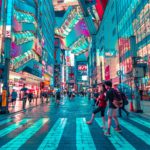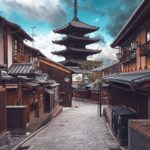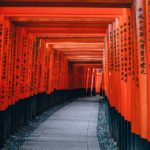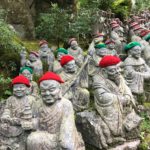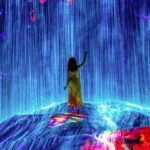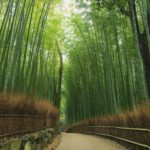Day 1: Tokyo
I wanted to start the first day off with just you, and I thought it may be best to include your son starting on the Day 2 activities, and thus time his arrival towards the end of this day so that you guys can start the 2nd day as early as possible. Thus we would use this time to do some of the activities that we spoke of that you seemed interested in, but thought that your son may not be as interested in. We also didn't want to bombard you on the first day, and allow you to get some rest after having traveled so far to get here, so these activities won't be very long. The first one is the visit to the Hokusai Art Museum that you expressed interest in. The building in and of itself is a work of art and this is the best places in Japan that you can experience Hokusai's legacy. The second location is the sake learning center. This is the place that has different types of sake from various regions all around Japan. When people think of Japanese spirits, they typically think of nihonshu, or shochu but there are a lot of surprising spirits that are similar to dessert wines like umeshu, and yuzushu as well. It's an eye-opening experience, and obviously you'll get to taste all of the spirits as well. If you don't mind, someone from our end may join you and your guide, as this is one of our most enjoyable activities. Activities:
- Hokusai's ukiyoe art museum
- Sake learning (+tasting) center
Day 2: Nikko
Today, I wanted to start your trip off with something spectacular, and so I planned for your visit to Nikko to be on this day. Nikko is just north of Tokyo, and the best way to get there is by train. There is a train that actually has a private cabin (which is pretty rare for Japan), and it's the most enjoyable way to watch the landscape change. Nikko is the resting place for the shogun who unified Japan. There is a shrine there in his honor, and it by far the most ornate of any shrine I've seen in the country. The first half of this day is best spent with a knowledgeable guide who can give you all of the history of Nikko, and the shrines so that you can appreciate it best. The shrine itself is planted right in the middle of a large cedar forest, which only adds to its majesty. We spoke briefly about this location on the phone. After that, the next stop is more lighthearted. The open-air, Edo-era museum/theme park, which isn't located too far from the shrine. I love visiting here, and they usually have to kick us out, because we typically stay until closing hours. There is soooo much to do, see and learn while visiting. This is the place we discussed on the phone, that will let you dress up in traditional Edo-era clothing before entering the park, if you'd like. There are impromptu sword fights, hidden ninjas in the streets, areas that teach you about the crafting process of katanas (it is insanely complex), and even stations where you can try your hand at creating traditional Japanese crafts (my favorite of which is the daruma doll painting). It's a lot of fun. As transportation in the area can be very complicated, we would like to arrange a private car for you and your guide on this day. We would also like to make dinner arrangements for the both of you when you return to Tokyo. Activities:
- Visit to Toshogu Shrine (guided)
- Visit to Edo open-air museum/theme park
Day 3: Tokyo
The second day will be a bit more modern and somewhat "futuristic" even. *I wanted to start the day off with a visit to one of Tokyo's most well-known areas, especially with people who are fans of anime. Akihabara is a place that is unique in that so much of the area is dedicated to both making, and appreciating the art of anime and all things electronic. I didn't get the chance to ask you over the phone when we spoke, but if you son is a fan of anime, then this would be an excellent addition to the itinerary. We have a guide that we use, who is an anime otaku herself, and thus knows the area really well. There is a shrine in the neighborhood that performs blessings for your electronics too. I've seen people take smartphones in, or even a Playstation. The next stop is a man-made island in Tokyo bay that houses a lot of Japan's concept tech, and has essentially become one of the areas in Japan that is seen as the most "techy". Even the train to get there is an unmanned, automated monorail. This trip would be to visit the TeamLab Borderless art space that we previously discussed. This is another place that I've gotten lost in and ended up spending hours there. It's mesmerizing. They also have a small restaurant that uses the same art installations, but they are customized for that restaurant, please let me know if this is something that you'd be interested in. To get back to Tokyo proper, I wanted to arrange a small 'cruise' of Tokyo Bay that would put you guys back in the city. Going under the same Rainbow Bridge that you saw while on the monorail is the highlight for me. Activities:
- *Akihabara tour or Asakusa area tour
- TeamLab digital art space
- Short night cruise of Tokyo Bay
Day 4: Osaka
From the modern capital in the east, to the traditional capital in the west. We typically use Kyoto as a central place to base our clients, because of its proximity to Osaka, and other Kansai locations. For this day, although you have taken many different types of trains, this will be the first high-speed, shinkansen bullet train in your journey. Today is a festival day, and so we want to dedicate the entire day to taking in the festivities of the Kishiwada Danjiri Matsuri in the Osaka Bay area. This festival is the best way to witness the difference in personality between people in western an eastern Japan. The Danjiri Matsuri is pretty extreme. I previously sent you a video link, but you can see it in action again here. The festival is also the best way to try traditional Japanese street foods, as there will be plenty of yatai out on the streets selling a variety of foods during the events. Activities:
- Danjiri Matsuri in Osaka area
Day 5: Kyoto
Today we want you to be able to take in some of the sites of early Autumn, and also to visit some of Kyoto's classics. The day will start with a boat ride down the Hozugawa river. This ride however is a traditional 3-manned wooden boat, and is a portion of the route that used to be used in the past to transport cargo between Osaka and Kyoto. The ride is beautiful, and a lovely way to take in the natural surroundings of Kyoto. It ends in the Arashiyama district, where you will have the chance to visit one of Japan's most beautiful zen gardens (a UNESCO World Heritage Site). The garden is somehow beautiful and different in every season. It was masterfully designed. Arashiyama is also home to a lot of other interesting places, and so it is a great place to spend some free time exploring. There is an path behind Tenryuji that is famous for being lined with extremely tall bamboo. I'm going to include a picture of it in the small gallery below. After that, I wanted to make sure that you didn't leave the Kansai area without seeing Japan's most famous shrine, Fushimi Inari. This is the shrine with thousands of red-orange torii gates on the mountain that possesses the same name. It's been in tons of movies, like Memoirs of a Geisha, so I think it should be instantly recognizable. There is an area in Kyoto called Pontocho Alley. The street is very narrow, and it's lined with hundreds of restaurants. It is the perfect place for dinner. We can make a few recommendations, or find something based on what you guys would like to try Activities:
- Hozugawa traditional riverboat ride
- Arashiyama area exploration
- Tenryuji zen garden visit
- Fushimi Inari visit
Day 6: Kyoto
As today is the last day with your son, we wanted this day to be a special one, and we saved what we thought would be the most interesting thing for you both to do together for this day, the kogatana sword forging. The forging will take place with at the swordsmith's forge, and you will be accompanied by an interpreter who will give you the instructions. The process will traditional, and I believe they will engrave your names on the hilt when you finish. As this is a relatively long process (around 4-6 hours), we have left the rest of the day open for you guys to explore Kyoto, and check off any boxes that you wanted to check while in the area. Activities:
- Sword forging kogatana
Day 7: Himeji
The plans for this day are relatively simple. We'd like to plan a trip to both the Imperial Palace in Kyoto, and Himeji Castle. Both are extraordinary in their own right. The Imperial Palace in Kyoto is much more... palatial than the one in Tokyo. It's massive, and it's also much more accessible than the one in Tokyo. I think that almost everything in Japan has been rebuilt at least once. Japan goes through a lot of natural disasters, and so it has lost a lot of its landmarks to earthquakes, fires and tsunamis. However Himeji Castle is one of the few rare locations that is mostly untouched. It's a chance to step back in time. Both of these locations are best experienced with a knowledgeable guide. Activities:
- Kyoto Imperial Palace visit
- Himeji Castle visit
Day 8-9: Kumano Kodo
This leg of your trip will be spent at a shukubo, or a traditional stay with Buddhist monks. This particular area is famous for being a pilgrimage path for monks in antiquity. We spoke about it briefly over the phone, but it is an area where you can stay with the monks, and participate in as few or as many of the rites that you wish to. It is also an excellent place for hiking, and this time of year should be quite nice for doing so, both temperature-wise, and seasonal changes-wise. I chose this location over the Tsuruoka location we discussed for a few reasons. The location in Tsuruoka is very tough to reach, and although it is also beautiful, and the traditions in that area are completely unique to Tsuruoka, and Tsuruoka alone, I thought it would be too much of a journey for a 10-day trip. I also chose this location, because it is a lot less intense. The Tsuruoka monks are known for some experiences that are more involved, like takigyo (meditating underneath a running waterfall), and steam room meditation, and even walking on coals. I thought that it may be a bit outside of what we were going for with this itinerary. Having said that, the monks in the area we've planned for do perform morning zazen meditation that you can participate in, and also fire rituals at night (but you don't have to walk on/in/or through it. Having said that, I did have the thought of replacing this leg with a visit to another location instead, so if it seems like something you may not be fully into, please let me know.
Day 10: Kansai ---> Tokyo
The trip back to Tokyo can be quite long by train, and it will take some time to reach the nearest bullet train station from the Kumano Kodo area. Thus we have left this day open for traveling back to Tokyo. We can make a reservations for dinner for you if you'd like, or if you think this time would be best spent catching up on rest, then we could leave it completely open.
Overview:
The five days that you spend with your son are quite packed. Please let me know if you think that it is too much. I really wanted to plan in a way that made the best of the five days that you have with him, and so I put a lot of activities in those days, and kind of eased up a bit so that you can recover afterwards, but I can totally understand if it is slightly overwhelming. Also, when we spoke you mentioned that you would like to be able to see the classics, but also wanted to spend time outside of the major cities. So we planned this in a way where the time that you did spend in the cities, and seeing the classic sites were with your son, and we used the remaining time to plan personal time in some of the smaller (and sometimes harder to reach) locations, so that time with your son is maximized. However, if you think that we should rearrange anything, or switch some of the days with your son out with some of the other days in the itinerary, please let me know. Speaking of maximizing your time, ten days is a relatively short period of time, when there is so much to see and do. I would like to make use of guides as much as possible so that you don't really have to fiddle with maps, and phones to find your way around. I do know (and appreciate) that guides don't necessarily fit into everyone's travel style. If you would prefer less guides, or not guides at all, please let me know. Some activities that I wanted to include, but did not find time for are:
- The kendo martial arts lesson (I didn't prioritize this one, as it seemed like something that maybe you weren't as interested in)
- Race car drifting (same reason)
- Tokyo history museum visit (I had a really excellent one in mind that is really hands-on, but I prioritized the other Tokyo activities)

